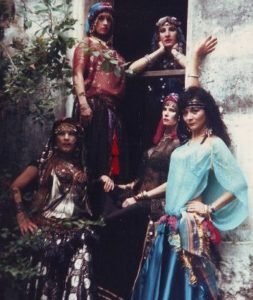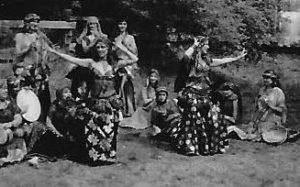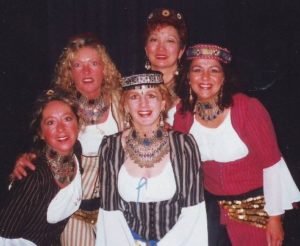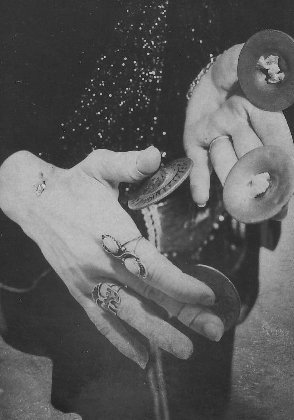Looking Back….
 I’ve been thinking about my career in dance and I’ve come to realize my experiences were different from many in the bellydance community, and thus my perceptions might differ from others, because my path in the bellydance community took a different route.
I’ve been thinking about my career in dance and I’ve come to realize my experiences were different from many in the bellydance community, and thus my perceptions might differ from others, because my path in the bellydance community took a different route.
My experience with dance began with my Grandfather in the American south, who would spontaneously burst into buck dance and flat-footing when he heard music. The expression on his face- an inward gaze- caught my attention and I wanted to know more about this magical thing that could take a person so much into themselves and music.
My experience with public shows started when I was 16. I loved dance, and spent hours practicing, and watching dancers on TV, at a local studio, in live shows, and I loved the whole experience: the dancing, the staging, the costuming. I loved the idea that a person could put on a show and create moments of shared experience with an audience.
While in high school (age about 16), I trained some other young women to dance as a group, and started booking performances at local events. At these events, I didn’t perform myself, but served as the director, choreographer and booking agent. This began my skills development for marketing art as entertainment.
A move to Alaska put an end to the group, but while in Alaska, having seen a native performing group, I began studying about folk/folkloric dance, listening to the music, watching every film I could find. I became intrigued by the way different cultures used similar human movements yet made them into entirely different dances, with a different feel, look, and so on. I wanted to understand the context, the back story, of each dance.

When I started college on the west coast of the US, I became involved in theatre and began learning folkdances from around the world. Again, I was caught up by how each dance could express a people, a tribe, or something about their history, or even the way of seeing the world. My involvement with an equestrienne drill team that did public shows honed my skills at not only examining how patterns of movement created or blocked flow, but marketing performance art as entertainment.
When a Turkish dancer, Shara, who had taught and performed on the east coast, moved to my town. I attended a talk she gave to a local women’s group about bellydance. That night I signed up with her for classes. After about 2 years with her, I branched into taking classes from Suzanna DelVecchio (American bellydance), Karija Dossett (American bellydance and folkdance) and Mafi, a woman from Iraq who taught private lessons. During this time I was also continuing my folkdance/folkloric study, as well as learning African dance with Afua N’Diaye. I became a passionate attendee at workshops throughout the Pacific Northwest, traveling everywhere I could to train. In addition, I cross-trained in other dance forms, taking from them what I felt would enhance my technical and performance skills.
So, I was learning to dance, studying dance as movement, taking classes in different forms of dance, reading about dance, and going to every bellydance show I could find (as well as attending choreography showcases in various dance genres), going to restaurants and clubs where dancers were featured.
I studied the different ways each dancer interacted with the music, moved her body, related to the audience, used her personal space and her dance space; I listened to countless bands live and bought and consumed hundreds of albums of Near and Middle Eastern, North African and other folk/folkloric music.
 It was while going to clubs, taking opportunities to dance at them (there were featured student and guest nights) and dancing at local clubs and restaurants, that I realized that, as more and more dancers developed, there would be a decrease in performing opportunities. I watched as wages went from $150 a night to, in some places, $25. I spoke with other dancers, we talked about forming a union, but the overriding fear was that if dancers tried to unionize, the owners would just hire dancers who would work for less because there were “plenty of dancers and not many clubs”, so the idea of a union faded away.
It was while going to clubs, taking opportunities to dance at them (there were featured student and guest nights) and dancing at local clubs and restaurants, that I realized that, as more and more dancers developed, there would be a decrease in performing opportunities. I watched as wages went from $150 a night to, in some places, $25. I spoke with other dancers, we talked about forming a union, but the overriding fear was that if dancers tried to unionize, the owners would just hire dancers who would work for less because there were “plenty of dancers and not many clubs”, so the idea of a union faded away.
During this time, I formed a small bellydance performing group from others who were dancing, some more experienced than myself, some less but all dedicated to the dance (and apparently I was unusual for the time in that I also obtained all required business and PRO licenses). Being the director of this group, I felt an obligation to create work for them, but I couldn’t see how clinging to a small pool of opportunity could do that. So in 1976 I made a decision to do something different. I decided that, instead of chasing after the few dance jobs there were, I would create a completely different approach and mainstream my dance group and the dancers.
Over the next few years, and with a growing dance ensemble, I joined the local Chamber of Commerce and the State Visitor and Convention Bureau, developed an entertainment advertising campaign, started a living telegram business with two partners, developed lecture-demo programs for libraries, schools, community colleges, and went door-to-door to every organization I could think of, including the MWR department with the military, to market the idea of a regular dance entertainment presentation.
We also performed gratis at some charity events, both because they were good causes and because I felt the audience would lead to later paid work (they did).

I know some pros scoff at the idea of living telegram businesses (then again, to me a pro understands that business is business, a show is a show), but when you have a number of dancers who need work, the living telegram was a lifesaver! It was a carefully regulated, monitored business; the dancers took no risks because we made sure to book safe venues and tasteful parties only (no bachelor parties) and the dancers did quite well. These dancers also performed in hundreds of small programs, individual dance jobs, dance/workshop tours, and so on.
I also produced and directed annual dance theatre productions, with guest performers from all over. These annual productions served two functions: they kept our performing skills well-honed and they enabled the dancers to develop followings, which in turn enabled them to book solo gigs, as each dancer was an independently licensed performer.
And the whole focus was on developing jobs from within the NON-dance community, developing NON-dance supporters and a solid, dependable audience and market for our dancing. I used performances IN the dance community to assess our skills, keep up to date, get skilled feedback… but my primary market was NON-dance. And as I watched the number of dance jobs in the dance community shrink, as I watched more and more dancers have to rely on other dancers for attendance at their events, as I watched wages drop, I knew that, for me, for us, I had made the right decision.
My main connection in the dance community was, and remains, through the workshops and dance clinics I teach.
For over 40 years, I danced, directed, produced and performed and loved every minute, earning a living at what I loved.
In Dec 2018 I will permanently end my career in dance. I said my main connection in the dance community was, and remains, through the workshops and dance clinics I teach. This is still true, though it all ends in 2018.
Which brings me to this:
When I attend haflas, I am disappointed to see so many non-performance ready dancers, who don’t seem to understand movement technique, don’t seem to let themselves go into the music. While a hafla should be seen as a party with no judgment, should be seen by the teachers and students as a place to hone skills and improve, the problem has become that haflas are being presented in such a way that the public perceives them as “shows” (yes, there is a difference between a hafla and a show).
I am concerned to see the lack of stage shows and full productions, which are where the professionals can be showcased and present the dance at its best (and I am speaking of ALL the permutations and inspired-by forms of dance, too).
Personally, I think this lack of striving for a professional level presentation has resulted in rising numbers of poorly disciplined dancers, and beginner level dancers, being presented to the public as “bellydancers”- this in turn has resulted in a decrease of interest in bellydance as a “legitimate performance art” from the general public, and a shrinking paying market.
My focus in teaching workshops and clinics has been, and remains, strictly to enhance or improve specific, targeted skill areas. While I have tried teaching at a few of the “cattle-call” events, it didn’t satisfy- I want to be able to take a dancer and see a visible, tangible improvement from the moment she enters the workshop or clinic to when she finishes. This means fewer movements thrown at the students, but it means each student walks out with new or improved skills. I want quality, not quantity. I want each student to understand movement technique and proper execution. When I teach my Teacher’s Primer, I want each teacher or potential teacher to walk away with better business and training skills, as well as being able to do a better job at helping each student improve.
I want to see a new rise of public stage shows or presentations or full stage productions that prove that this dance genre is viable and legitimate as a full-fledged dance discipline. I know it may no longer be possible, I recognize the type of person attracted to the dance form has changed, but it still is my hope that there are women out there who want to learn to dance, dance well and present dance as an art that derives from a craft that has been mastered. I want it to be seen as a legitimate, professional class public entertainment in all its forms- NOT just dance in clubs, but dance on stage. Not just dance for other dancers, but create a whole new audience that appreciates and enjoys the dance forms as an entertainment medium.
I don’t know what the future of the dance holds, but I hope it doesn’t end up relegated to the bin of “novelty dances” because teachers failed to understand, know and uphold not just dance standards and technical discipline, but failed to know performance standards as well.
I know there are exquisite, excellent- and demanding- teachers out there. There are still striving to educate, improve, and enrich the dance community, When you decide to take a class, workshop or clinic, give thought to what you want to learn, which teachers will give you that training, and what you want the end result to be.






